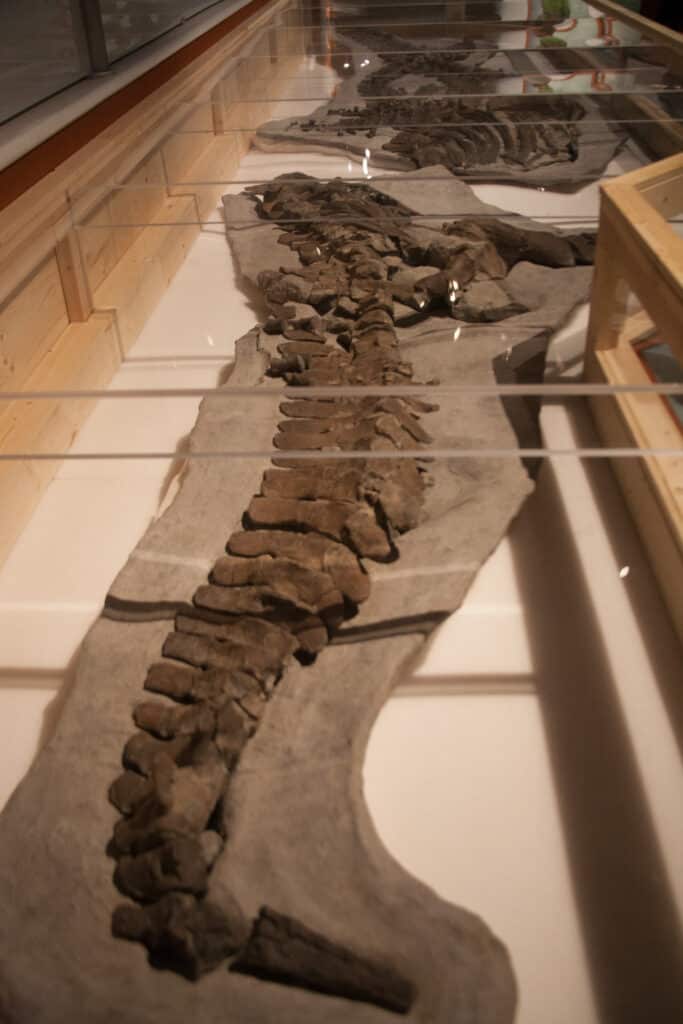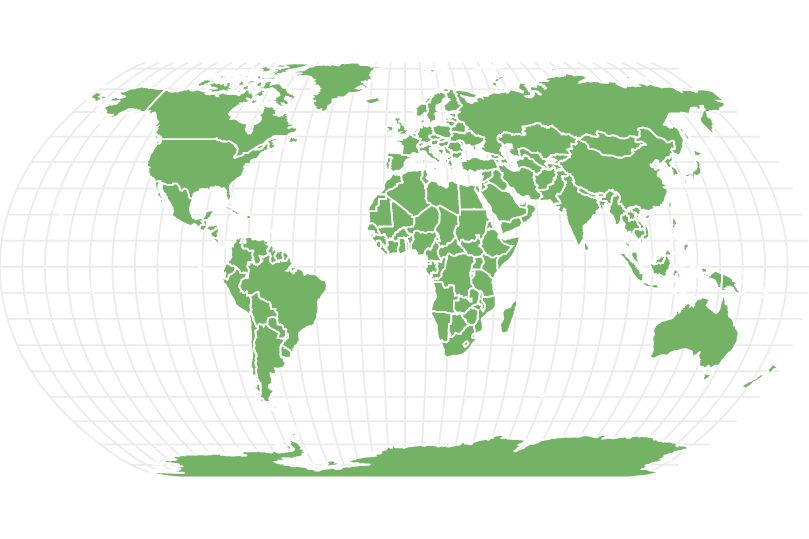The Albertonectes had the longest neck out of other Elasmosaurids.
Advertisement
Albertonectes Scientific Classification
- Kingdom
- Animalia
- Phylum
- Chordata
- Class
- Reptilia
- Order
- Plesiosauria
- Family
- Elasmosauridae
- Genus
- Albertonectes
- Scientific Name
- Albertonectes vanderveldei
Read our Complete Guide to Classification of Animals.
Albertonectes Conservation Status
Albertonectes Facts
Albertonectes Physical Characteristics
View all of the Albertonectes images!
Introduction
The Albertonectes (Albertonectes vanderveldei) was a genus of plesiosaur from the elasmosauridae family. They roamed the earth during the Late Cretaceous Period (100.5 to 66 million years ago) and are now extinct. The Albertonectes were different than your average dinosaur even though they are placed in the same category.
They were more similar to a type of air-breathing reptile that lived in the ocean. The Albertonectes had some of the most neck bones in comparison to many other animals. 76 neck bones have been discovered in the fossil.
Description & Size

The Albertonectes were first discovered by accident by a fossil company called Korite International which was looking for gem-quality ammonite shells.
©2,912 × 4,368 pixels, file size: 3.79 MB, MIME type: image/jpeg – License
The Albertonectes had the standard body of a plesiosaur with a long, straight neck that consisted of 76 bones, along with a short tail. They had short and stocky body that was broad, with four limbs that ended in flippers since they swam in the ocean and were not land animals.
Their neck was larger than other types of plesiosaurs at around 23 feet long, making up more than half their total body length which was 38 feet long in size. This makes them a big sea creatures that had the longest necks out of other Elasmosaurs in the family. The most distinctive feature of the Albertonectes was its long, stiff neck that lacked flexibility. However, since the fossil discovered in Alberta showed that the neck was likely broken, it is difficult for experts to determine how the Albertonecte’s neck was situated.
The Albertonectes weighed around 4.8 tons as an adult. Other traits that the Albertonectes had that made them different than other Elasmosaurus is their tapered front-sided projection of the pubic region all the way to the side of the acetabulum and an arch near their shoulders that were wider than the front of the scapula. The tail consisted of seven fused vertebrae. They likely had fused neural spines according to the adult specimen that was discovered.
Diet – What Did The Albertonectes Eat?
The Albertonectes was likely a carnivore, and they had surprisingly sharp teeth with large roots. These sharp teeth were able to grip onto small slippery fish, along with squid and small prey that they caught. Since they were part of the Elasmosauridae family, they probably had rows of upper and lower teeth that meshed together. This allowed them to hunt and eat smaller prey rather than catch larger ones. The jaw could have been slender if they resembled the other Elasmoausaurs. This would make them unable to hunt and dismember large prey. The Albertonectes likely catch small fish in the water column or ate invertebrates from the ocean bed.
Strangely, scientists discovered stones inside of the Albertonectes stomach cavity, but it is unknown why the Albertonectes ate stones. There are some theories to explain this behavior, for the digestion of ballast. The Albertonectes could have eaten the stones to aid with digestion, or they could have eaten it to make themselves heavier to swim close to the sea bed in search of food. Both theories are possible, especially since this behavior has been seen in other species of plesiosaurs. Paleontologists are still trying to theorize why plesiosaurs were ingesting stones.
Habitat – When and Where It lived
The Albertonectes lived 100.5 to 66 million years ago during the Late Cretaceous Period during the middle upper Campanian stage. They were a genus of marine creatures that inhabited the world’s oceans, but only one holocast specimen of the Albertonectes has been found. The Albertonectes were found in inland seas by the Western Interior Seaway along the eastern flank of the Rocky Mountains.
The Albertonectes seaway ranged from the Arctic Ocean to the Gulf of Mexico in a marine environment. Fossils of the Albertonectes indicated that they lived in open waters aside from only living near the shore.
Threats And Predators
It is unclear what predators the Albertonectes may have faced at the time. Scientists discovered that the fossil specimen of the Albertonectes had tooth marks from being scavenged by a shark from the Squalicorax shark genus. The coracoid tooth marks and shed teeth from the Squalicorax sharks means that the Albertonectes were likely preyed on by larger and more carnivorous shark species that preyed on large animals like plesiosaurs.
Other mosasaurs were also a possible threat to the Albertonectes, even though they were part of the same family. The Albertonectes likely didn’t face many predators even though they lacked the ability to defend themselves from predators because they were slow swimmers.
Discoveries and Fossils – Where It was Found
The Albertonectes were first discovered by accident by a fossil company called Korite International which was looking for gem-quality ammonite shells. They were searching for these shells in the Bearpaw Formation that is south of Lethbridge in Alberta. They used track hoes to excavate the ammonite shells which would sometimes bring fossils of mosasaurs to the surface. Eventually, the company came across the fossil of the Albertonectes in 2007 during the company’s diggings.
The Royal Tyrrell Museum then dispatched around 6 staff members to help the Korite International Company dig up the remains. The skull of the Albertonectes was not found, however, the rest of the body was intact. Removing the Albertonectes remains took about 3 weeks to fully remove and be taken back to the museum for further research. The specimen that was discovered was around 73.5 million years old. It was collected from the St. Mary River Section in Muddy Unit 1.
The Korite International company that found the Albertonectes remains was founded by Rene Vanderveld. This led to the species name being the Albertonectes vanderveldei translated to the “Van der Veld’s Alberta Swimmer”. This name is derived from Alberta where the holotype was found, but the genus of Albertonectes was first described by Tai Kubo, Mark Mitchell, and Donald Henderson recently in 2012.
Extinction – When Did It Die Out?
Albertonectes went extinct 100.5 to 66 million years ago after the Late Cretaceous Period in which they lived. The entire genus went extinct before the KT extinction which was a mass extinction that took out three-quarters of the animal and plant species that existed at the time. The KT extinction wiped out all remaining species of plesiosaurs, including any remaining Albertonectes.
The KT extinction event occurred 66 million years ago during the Cretaceous Period and the start of the Tertiary Period, ranking third in five major mass extinctions after wiping out 70% of the species.
This extinction event was theorized to have occurred from a crater that hit the earth’s crust and caused a large of dust and debris to enter the atmosphere, resulting in a tsunami, wind storms, acid rains, and severe volcanic activities. This would have affected the Albertonecte’s ability to thrive, and they went extinct before the situation got worse.
Similar Animals to The Albertonectes
Albertonectes are closely related to several species of plesiosaurs and mosasaurs.
- Attenborosaurus- An extinct genus of pliosaurid that lived during the Early Jurassic Period. They had long necks and flipper-like limbs.
- Elasmosaurus- A genus of extinct plesiosaur that lived during the Late Cretaceous Period and had a long neck.
- Hydrotherosaurus- An extinct genus of elasmosaurid plesiosaurs that had long necks and flippers and lived during the Maastrichtian stage.
Albertonectes FAQs (Frequently Asked Questions)
When was the Albertonectes alive?
The Albertonectes roamed the earth during the Late Cretaceous Period around 100.5 to 66 million years ago.
How big was the Albertonectes?
The Albertonectes had a total body length of 38 feet, with their tail being as long as 22 feet. They weighed around 4.8 tons, and their long, stiff necks were their most distinctive feature.
What did the Albertonectes eat?
They ate small prey such as fish, squid, and crustaceans that they caught along the seabed. The Albertonectes were a carnivore with small, sharp teeth framing their mouths.
Thank you for reading! Have some feedback for us? Contact the AZ Animals editorial team.
Sources
- Wikipedia , Available here: https://en.wikipedia.org/wiki/Albertonectes
- Canadian Encyclopedia , Available here: https://www.thecanadianencyclopedia.ca/en/article/albertonectes
- Carnivora net, Available here: https://carnivora.net/albertonectes-vanderveldei-t5386.html

















